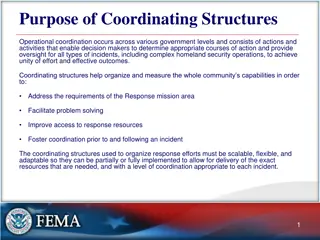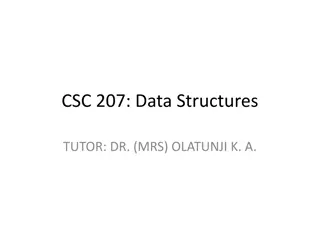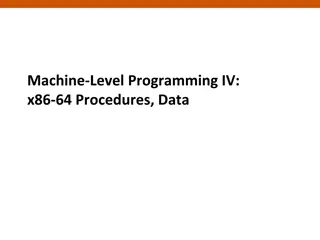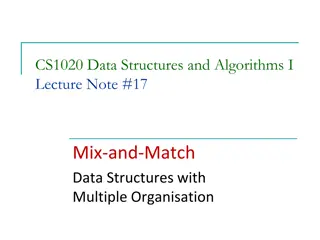Waveguiding Structures Overview
In microwave engineering, waveguiding systems confine and guide electromagnetic energy through various structures like parallel plate, rectangular, circular waveguides, and more. The general notation, Helmholtz equation, and key concepts related to wave propagation are discussed in this overview.
Download Presentation

Please find below an Image/Link to download the presentation.
The content on the website is provided AS IS for your information and personal use only. It may not be sold, licensed, or shared on other websites without obtaining consent from the author.If you encounter any issues during the download, it is possible that the publisher has removed the file from their server.
You are allowed to download the files provided on this website for personal or commercial use, subject to the condition that they are used lawfully. All files are the property of their respective owners.
The content on the website is provided AS IS for your information and personal use only. It may not be sold, licensed, or shared on other websites without obtaining consent from the author.
E N D
Presentation Transcript
Web programming using PHP What have we learnt? Underlying technologies of database supported web sites Constructing database supported web sites Accessing the MySQL database from PHP scripts Example: A mailing list auto_increment in MySQL CSC 405: Web Application Engineering II 8.1
What have we learnt? Overview: A PHP file: <html> <head><title>Hello World</title> </head> <body> <? echo "<b>Hello</b> "; echo "<i>WORLD</i>"; ?> </body> </html> CSC 405: Web Application Engineering II 8.2
Until now: Variables, numbers, strings and arrays Computations if-constructs and loops Functions and code reuse Entering user data using forms Validating user data using regular expressions CSC 405: Web Application Engineering II 8.3
General client-server database architechture Clients can potentially run on different physical machines Database processes run on the same physical machine One database process is established for each client connection Database processes are maintained by a database daemon CSC 405: Web Application Engineering II 8.4
CGI-scripts and database access (CGI = Common Gateway Interface) Pros of CGI-scripts All major web servers support CGI-scripts All programming languages can be used to construct CGI-scripts Cons of CGI-scripts The CGI-program is started as a new operating system process each time a request arrives Additionally, a new database server process is started for each request The CGI-program must be authorised by the newly created database server process It takes some time to close the CGI-program CSC 405: Web Application Engineering II 8.5
Two strategies for connecting the web server and database Slow database connection using CGI: Fast database connection using fixed connections: CSC 405: Web Application Engineering II 8.6
Web servers with fixed database connections and scripting Pros: Fast startup of interpreted program Fast access to existing database connections Cons: Tightly connected to a specific web server possibly non-portable CSC 405: Web Application Engineering II 8.7
Java Applets Pros: Fast execution on the client (browser), at the expense of longer downloading time Potential for good usability Cons: Safety problems an additional open port to the database Licensing problems as a port for database connection must be open, typically the license paid is proportional to the number of concurrent users Potentially many database connections and many running database servers when can one assume that a database connection is no longer needed? Is not supported or enabled on all browsers, and is problematic with PDAs CSC 405: Web Application Engineering II 8.8
Safety A hacker attack on data requires the following: 1. A connection to the database servers IP address 2. Password to the database server or 1. A connection to the server s IP address 2. A root password (by hacking the machine) or . . . To prevent attacks: Move the database server behind a firewall and allow only connections to the web server Move the web server behind a firewall and allow only connections via port 80 CSC 405: Web Application Engineering II 8.9
Constructing database supported web sites We construct a database supported web site using the following steps: Step 1: Constructing a data model Which information should be stored and how should it be represented? This is the hard part!!! Step 2: Developing data transactions How do we insert data into the database? How do we extract data from the database? Step 3: Constructing web-forms for implementing data transactions The user interface is HTML code (forms) Step 4: Constructing PHP-files for implementing data transactions SQL (Structured Query Language) is used for the actual data transactions This is the easy part! Note: The more time you spend on Step 3, the easier Step 4 becomes! CSC 405: Web Application Engineering II 8.10
Example: A mailing list Using the mailing list system, we must be able to create a list of names and emails for distributing emails. The same common list is maintained by all people using the system. The only information stored are the names and email addresses. Step 1: The data model CREATE TABLE maillist ( email varchar(100) not null, name varchar(100) not null ); We assume that no two persons use the same email address, i.e., it is unique. We insist that the name as well as the email address are present. CSC 405: Web Application Engineering II 8.11
Example: A mailing listcontinued Step 3: Constructing web forms and site maps The boxes in the diagram represent states where HTML code is displayed in a browser Unlabelled arrows represent links to a new HTML page, possibly generated by a PHP script Labelled arrows represent transactions that update the database by running a PHP script CSC 405: Web Application Engineering II 8.12
Example: A mailing listcontinued Step 3: Constructing web forms: maillist_add.html: <HTML> <BODY> <H2>Add Yourself to Mailing List</H2> <FORM ACTION="maillist_add.php" METHOD=POST> <TABLE> <TR><TD>Email:<TD><INPUT NAME=email></TR> <TR><TD>Name: <TD><INPUT NAME=name></TR> <TR><TD COLSPAN=2><INPUT TYPE=SUBMIT VALUE=Add></TR> </TABLE> <HR><A HREF="mailto:webmaster@my.com">webmaster@my.com</A> </BODY></HTML> Note: The file maillist_add.php is the form action The form contains two fields called email and name CSC 405: Web Application Engineering II 8.13
Example: A mailing listcontinued Step 4: Constructing PHP filer The file maillist.php displaying email addresses: <HTML><BODY><H2>Mailing list members</H2><UL> <? // Establish database connection $db = mysql_connect("mysql.itu.dk", "W2_panic", "***"); mysql_select_db("W2_F2004_panic", $db); // Extract rows from the table $rows = mysql_query("SELECT email, name FROM maillist"); // Iterate through the rows while ( $row = mysql_fetch_row($rows) ) { // Display a single row echo "<LI> <A HREF=\"mailto:$row[0]\">$row[1]</A>"; } ?> <P><LI><A HREF="maillist_add.html">Add Yourself</A> </UL><HR><A HREF="mailto:webmaster@my.com">webmaster@my.com</A> </BODY></HTML> CSC 405: Web Application Engineering II 8.14
Example: A mailing listcontinued The file maillist_add.php adding an email address: <? // Establish database connection $db = mysql_connect("mysql.itu.dk", "W2_panic", "***"); mysql_select_db("W2_F2004_panic", $db); // Insert data into the database mysql_query("INSERT INTO maillist (email, name) VALUES ( $email , $name )"); header("Location: maillist.php"); // Jump to maillist.php ?> Note: By calling the function header with location maillist.php, information is sent to the browser (via HTTP) informing it to request the file maillist.php from the server. As this happens rapidly and without user interaction the result is that the updated mailing list is displayed for the user. Are there any inconveniencies or defects in the scripts above? CSC 405: Web Application Engineering II 8.15
Using an include file for establishing a connection mydb.php By using an include file, we avoid writing password information in all files: <? function error ( $msg ) { echo "<HTML><BODY><H2>Error in PHP script</H2>$msg</BODY></HTML>"; exit(); } // function for establishing connection to the database function mydb_connect() { $dbhost = "mysql.itu.dk"; $user = "W2_panic"; $database = "W2_F2004_panic"; $passwd = "***"; $db = mysql_connect($dbhost, $user, $passwd); if ( $db == 0 ) { error ("Connection to database on $dbhost failed"); } if ( mysql_select_db($database, $db) == 0 ) { error ("Failed to select database $user "); } }?> Note: We check the return values from mysql_connect and mysql_select_db CSC 405: Web Application Engineering II 8.16
Extending the mailing list example Let us extend our mailing list example so that it is possible to remove names from the list We consider the four steps again: Step 1: The data model is unchanged (table maillist) Step 2: The following data transaction is added: Deleting email and corresponding name DELETE FROM maillist WHERE email = gates@microsoft.com ; CSC 405: Web Application Engineering II 8.17
Extending the mailing list examplecontinued Step 3: Constructing a site map: The file maillist2_del.php deletes a row from the table This file expects a form variable email, transferred in a link in the file maillist2.php: maillist2_del.php?email=gates@microsoft.com CSC 405: Web Application Engineering II 8.18
Extending the mailing list examplecontinued Step 4: Constructing PHP files The file maillist2.php: <HTML><BODY><H2>Mailing list members (version 2)</H2><UL> <? include("mydb.php"); mydb_connect(); // Extract rows from the table $rows = mysql_query("SELECT email, name FROM maillist"); // Iterate through the rows while ( $row = mysql_fetch_row($rows) ) { // Display a single row echo "<LI><A HREF=\"mailto:$row[0]\">$row[1]</A> -- <A HREF=\"maillist2_del.php?email=$row[0]\">delete</A>"; }?> <P><LI><A HREF="maillist2_add.html">Add Yourself</A> </UL><HR><A HREF="mailto:webmaster@my.com">webmaster@my.com</A> </BODY> </HTML> // Include utilities // Connect to the database CSC 405: Web Application Engineering II 8.19
Extending the mailing list examplecontinued The file maillist2_del.php: <? include("mydb.php"); // Check form variables if ( ereg("[a-zA-Z][a-zA-Z.0-9-]*@[a-zA-Z.0-9-]+", $email) == 0 ) { error("Go back and enter an email!"); } mydb_connect(); // Delete a row mysql_query("DELETE FROM maillist WHERE email = $email "); // Jump to the main page header("Location: maillist2.php"); ?> Note: We check that the form variable email is a valid email address Next time: We consider among other things how to send email to the email addresses // Include utilities // Connect to the database CSC 405: Web Application Engineering II 8.20
Generating unique ID numbers in MySQL In MySQL you can use auto_increment to generate fresh ID numbers automatically when inserting new rows into a table Example: CREATE TABLE Users (id int auto_increment primary key, name varchar(100) not null); INSERT INTO Users (name) VALUES ( Martin Elsman ); INSERT INTO Users (name) VALUES ( Niels Hallenberg ); Other database systems provide similar functionality In PHP, to get the ID generated for an AUTO_INCREMENT column by an INSERT query, you use the mysql_insert_id function: <? // Insert a new row mysql_query("INSERT INTO Users (name) VALUES ( Martin Elsman )"); // Get the auto_increment id column echo "Martin Elsman got ID number ".mysql_insert_id(); ?> CSC 405: Web Application Engineering II 8.21
Exercise Constructing a commentary service Add a functionality allowing the readers of your web pages to comment them. . . CSC 405: Web Application Engineering II 8.22























